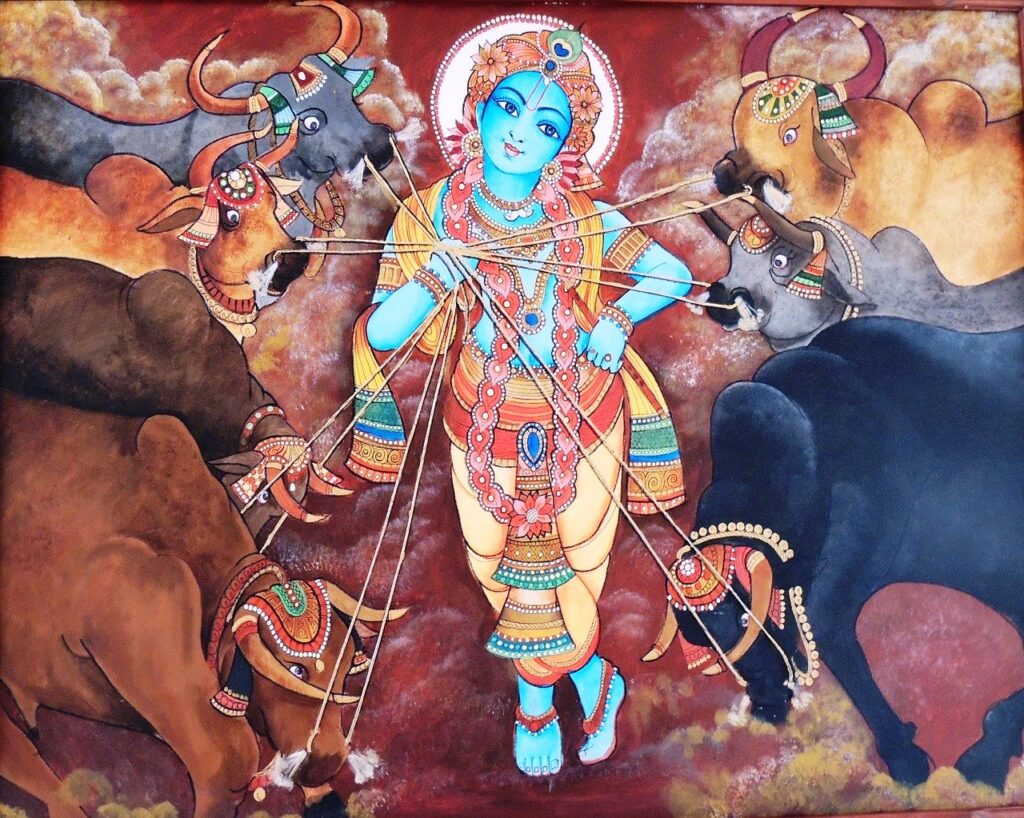
Bhagavad Gita provides extensive descriptions of the material nature, which is known as ‘Prakriti’ and is considered an energy of the Supreme Being. Prakriti governs the material world and all its 8.4 million species of life. The living beings who are essentially spirit souls, are bound to this material world through the three modes of material nature, namely – sattva (mode of goodness), rajas (mode of passion) and tamas (mode of ignorance). When the living entity, who is part and parcel of the Supreme Lord, comes in contact with this world of matter, it becomes conditioned by a combination of these three modes, and forgets its eternal free nature. The living entity, thus conditioned by the modes of material nature, seeks egoistic satisfaction through its senses, mind, and intelligence. This attachment to material desires leads to the cycle of birth and death. It is a vicious cycle that binds the living entity and impedes its spiritual progress. However, the Bhagavad Gita also provides guidance on how to transcend these modes and achieve liberation from the material world. By understanding the nature of Prakriti and the modes of material nature, one can break free from the cycle of birth and death and attain spiritual enlightenment.
#1 Material Nature or ‘Prakriti’ is an energy of the Supreme Lord
The Supreme Lord is the director of material nature, also referred to as ‘Prakriti’. In the Bhagavad Gita, Krishna enlightens Arjuna about the nature of ‘Prakriti’ as one of his energies that governs and oversees the material creation. Hence Krishna, the Supreme Lord, is energetic while ‘Prakriti’ is one of his innumerable energies.
mayadhyaksena prakritih
suyate sa-characaram
hetunanena kaunteya
jagad viparivartate
(Bhagavad Gita 9.10)
–
O son of Kunti, this material nature, which is one of My energies, is working under My command thereby producing all moving and nonmoving beings. Under its rule, this manifestation is created and annihilated again and again.

The energy of the Supreme Lord exhibits itself in diverse modes across different realms. On the platform of Suddha-sattva (spiritual realm), the same energy of the Lord manifests as Yoga-Maya, which is his internal potency. This internal potency is represented by Subhadra, the sister of Lord Krishna, whose name itself means ‘auspicious’. Subhadra Devi plays a crucial role in facilitating the spiritual progress of devotees by providing that which is auspicious while eliminating all that is inauspicious.
On the other hand, the external energy of the Supreme Lord, Maha-Maya shakti, operates in the material realm. She is a shadow of the Lord’s internal potency and is represented by devi Durga.
#2 Gunas – Three modes of Material Nature
As discussed previously, the material nature consists of three gunas (modes). These Gunas or modes of material nature are – sattva (mode of goodness), rajas (mode of passion) and tamas (mode of ignorance). When the living entity, who is part and parcel of the Supreme Lord, comes in contact with this world of matter, it becomes conditioned by a combination of these three modes, and forgets its eternal free nature and begins to identify himself with one of these three modes or a combination of these three modes. The living entity, thus conditioned by the modes of material nature, seeks egoistic satisfaction through its senses, mind, and intelligence. This attachment to material desires leads one to be imprisoned in this material world and undergo the repeated cycles of birth and death.

The modes of material nature are subtle forces that influence the behavior of human beings and every aspect of their physical, mental and emotional well-being. The mode of goodness, being pure, is immaculate and enlightening. It captivates the soul through attachment to happiness and knowledge, and creates an environment of tranquility, calmness, and harmony. The mode of passion, on the other hand, is characterized by attraction and arises from desires. It binds the soul through attachment to action and generates an insatiable longing for material possessions, leading to feelings of dissatisfaction and frustration. The mode of ignorance, which deludes everyone, arises from lethargy and inertia. It binds the soul through negligence, indolence, and slumber, resulting in a state of distress. This mode is responsible for clouding one’s judgment and preventing spiritual progress.
Wisdom springs from goodness, greed from passion, and negligence from ignorance. Individuals who operate in the mode of goodness, having attained spiritual insight, are relatively unaffected by the sufferings of the material world. On the other hand, people who operate in the mode of passion are driven by ambition and constantly pursue material pleasures and societal acclaim. Despite achieving many worldly accomplishments, they remain disillusioned and can never achieve lasting fulfillment. Individuals operating in the mode of ignorance tend to be indifferent to everything, leading to misery since they do not consider the consequences of their actions. They suffer the consequences of their ignorance and lack of discernment.
According to Bhagavad Gita, individuals who pass away while operating in the mode of goodness are reborn on the planets of the sages. Those who pass away while operating in the mode of passion are reborn among individuals engaged in fruitive activities. And individuals who pass away while operating in the mode of ignorance are demoted to an animal life.
To illustrate these three modes, consider a scenario where three people are enjoying a movie in a theater. One person is operating in the mode of goodness, another in the mode of passion, and the third in the mode of ignorance. If a fire were to break out in the theater, the person operating in the mode of ignorance (tamas) would likely freeze in terror without taking any action. The person operating in the mode of passion would instinctively run towards the exit without much reflection. In contrast, the person operating in the mode of goodness would take thoughtful action by looking for a fire extinguisher to put out the fire.
This example demonstrates that the mode of ignorance lacks both action and reflection, while the mode of passion involves instinctive action with minimal reflection. The mode of goodness, however, involves both action and thoughtful reflection.
#3 Material Nature subjects living beings to Threefold miseries
Material Nature has a unique purpose of purifying the consciousness of living beings through the experience of threefold miseries of material existence, namely:
- those arising from one’s own mind and body – Suffering from diseases
- those inflicted by other living beings – robbery, conspiracy, etc
- those from natural catastrophes – famine, earthquake, etc

These miseries are like the blows of a hammer on a piece of steel, forging and shaping the living entity towards spiritual growth. As the soul repeatedly undergoes these miseries, it gradually realizes the futility of material life and seeks to transcend the three modes of material nature.
#4 Rising above the Modes of Material Nature
mam ca yo vyabhicarena
bhakti- yogena sevate
sa gunan samatityaitan
brahma-bhuyaya kalpate
(Bhagavad Gita 14.26)
–
Engaging in complete devotional service and not faltering in any situation leads one to immediately transcend the influence of the modes of material nature and attain the level of Brahman.
Spirit and matter are opposing forces and one can either live in spiritual or material consciousness. The Supreme Lord possesses countless energies that can be categorized as internal, marginal, and external. Those who seek the shelter of the Supreme Lord belong to His internal energy while this temporary world of matter falls under His external energy. Living entities belong to the marginal potency of the Supreme Lord and have a choice to serve either the spiritual or material world. Those who are controlled by the external potency become misguided and indulge in sense gratification, leading to frustration. However, those who engage in devotional service of the Supreme Lord are protected by His internal energy.

The spirit soul is inherently designed to love and be loved, and this love is best fulfilled when directed towards the Supreme Spirit, God. The soul is a part of the Supreme Lord and is bound to Him by love. However, when a soul forgets this relationship, it becomes attached to the temporary world of matter, seeking love and attachment in inferior objects. This material entanglement only provides fleeting pleasure, causing frustration and alienation from the soul’s eternal spiritual reality. The soul’s natural propensity for devotional service cannot be substituted by material attachment, and only a loving relationship with God can provide true spiritual bliss.
The afflictions caused by material nature serve as a means for the living being to recognize its forgotten connection with the Supreme Lord. The living entity can be compared to vapor that transforms back into water when it is no longer boiling and returns to room temperature. Similarly, the living entity can regain its original pure and blissful nature, free from material contamination, as soon as it revives its eternal loving relationship with the Supreme Lord.
Dhruva Maharaj, son of King Uttanapada, desired a position greater than that of his father and even the creator of the universe, Lord Brahma. After leaving his home due to insults from his stepmother, he met the sage Narada who instructed him in bhakti and gave him a mantra to worship Lord Krishna. Dhruva followed Narada’s instructions and meditated on Krishna in Madhuvana, leading to the Lord personally appearing before him. Dhruva was then blessed with a kingdom and eternal residence in the spiritual world, and his desires for prestige and sovereignty were purified by devotional service unto the Supreme Lord. The story in the fourth canto of Srimad Bhagavatam (Bhagavata Purana) illustrates how following the process of devotional service (bhakti) under the guidance of a pure devotee can elevate one to the spiritual platform, even from the mode of passion.
#5 How to worship Maa Durga – the superintending deity of this material nature ?
The Gopis of Vrindavana serve as a model for the proper way to worship Devi Katyayani, also known as Durga. These unmarried girls were already devoted to Krishna and began their worship of Katyayani at the beginning of the Hemanta season with a vow. They would purify themselves by eating Havisyanna and then offer their worship to Katyayani early in the morning after bathing in the Yamuna river. Their worship involved creating a deity of the goddess and presenting offerings of sandalwood pulp, garlands, incense, fruits, grains, and twigs of plants.

The gopis prayed to Katyayani for the blessing of attaining Krishna, not for material gains, which is the ideal way to worship the energy of the Supreme Lord. Rather than seeking material pleasures or opulence, one should focus on transcending the modes of material nature through engaging in the devotional service of the Supreme. By doing so, one can achieve everlasting bliss.